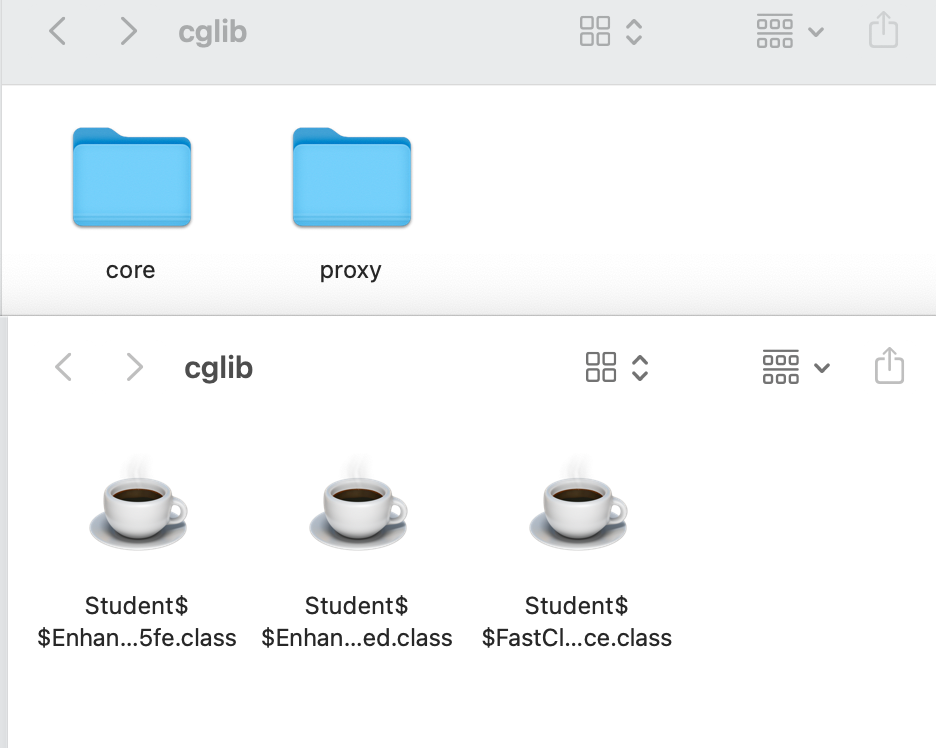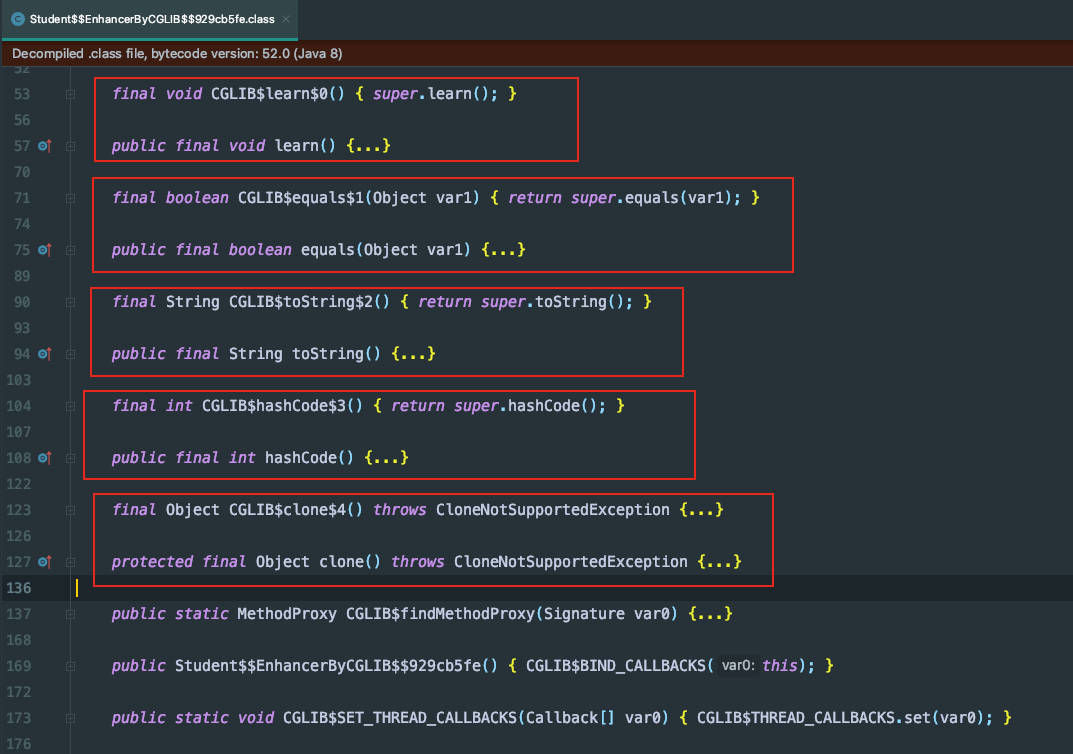cglib 动态代理
cglib 介绍
CGLIB 是一个开源项目,一个强大高性能高质量的代码生成库,可以在运行期拓展 Java 类,实现 Java 接口等等。底层是使用一个小而快的字节码处理框架 ASM,从而转换字节码和生成新的类。
理论上我们也可以直接用 ASM 来直接生成代码,但是要求我们对 JVM 内部,class 文件格式,以及字节码的指令集都很熟悉。
这玩意不在 JDK 的包里面,需要自己下载导入或者 Maven 坐标导入。
我选择 Maven 导入, 加到 pom.xml 文件:
<dependencies> <dependency> <groupId>cglib</groupId> <artifactId>cglib</artifactId> <version>3.3.0</version> </dependency></dependencies>
复制代码
Student.java:
public class Student { public void learn() { System.out.println("我是学生,我想学习"); }}
复制代码
MyProxy.java(代理类)
import net.sf.cglib.proxy.MethodInterceptor;import net.sf.cglib.proxy.MethodProxy;
import java.lang.reflect.Method;
public class StudentProxy implements MethodInterceptor { public Object intercept(Object obj, Method method, Object[] args, MethodProxy proxy) throws Throwable { // TODO Auto-generated method stub System.out.println("代理前 -------"); proxy.invokeSuper(obj, args); System.out.println("代理后 -------"); return null; }
}
复制代码
测试类(Test.java)
import net.sf.cglib.core.DebuggingClassWriter;import net.sf.cglib.proxy.Enhancer;
public class Test { public static void main(String[] args) { // 代理类class文件存入本地磁盘方便我们反编译查看源码 System.setProperty(DebuggingClassWriter.DEBUG_LOCATION_PROPERTY, "/Users/aphysia/Desktop");
Enhancer enhancer = new Enhancer(); enhancer.setSuperclass(Student.class); enhancer.setCallback(new StudentProxy()); Student student = (Student) enhancer.create(); student.learn();
}}
复制代码
运行之后的结果是:
CGLIB debugging enabled, writing to '/Users/xuwenhao/Desktop'代理前 -------我是学生,我想学习代理后 -------
复制代码
在我们选择的文件夹里面,生成了代理类的代码:
源码分析
我们先要代理的类,需要实现MethodInterceptor(方法拦截器)接口,这个接口只有一个方法 intercept,参数分别是:
obj:需要增强的对象
method:需要拦截的方法
args:要被拦截的方法参数
proxy:表示要触发父类的方法对象
package net.sf.cglib.proxy;import java.lang.reflect.Method;public interface MethodInterceptor extends Callback { public Object intercept(Object obj, java.lang.reflect.Method method, Object[] args, MethodProxy proxy) throws Throwable;}
复制代码
再看回我们要创建代理类的方法 enhancer.create(),这个方法的意思:如果需要,生成一个新类,并使用指定的回调(如果有的话)来创建一个新的对象实例。使用超类的无参数构造函数。
public Object create() { classOnly = false; argumentTypes = null; return createHelper(); }
复制代码
主要的方法逻辑我们得看 createHelper(),除了校验,就是调用 KEY_FACTORY.newInstance() 方法生成 EnhancerKey对象,KEY_FACTORY 是静态 EnhancerKey 接口,newInstance()是接口里面的一个方法,重点在super.create(key)里面,调用的是父类的方法:
private Object createHelper() { // 校验 preValidate(); Object key = KEY_FACTORY.newInstance((superclass != null) ? superclass.getName() : null, ReflectUtils.getNames(interfaces), filter == ALL_ZERO ? null : new WeakCacheKey<CallbackFilter>(filter), callbackTypes, useFactory, interceptDuringConstruction, serialVersionUID); this.currentKey = key; Object result = super.create(key); return result; }
复制代码
AbstractClassGenerator 是 Enhancer 的父类,create(key) 方法的主要逻辑是获取类加载器,缓存获取类加载数据,然后再反射构造对象,里面有两个创造实例对象的方法:
fistInstance(): 不应该在常规流中调用此方法。从技术上讲,{@link #wrapCachedClass(Class)}使用{@link EnhancerFactoryData}作为缓存值,后者支持比普通的旧反射查找和调用更快的实例化。出于向后兼容性的原因,这个方法保持不变:只是以防它曾经被使用过。(我的理解是目前的逻辑不会走到这个分支,因为它比较忙,但是为了兼容,这个 case 还保存着),内部逻辑其实用的是ReflectUtils.newInstance(type)。
nextInstance(): 真正的创建代理对象的类
protected Object create(Object key) { try { ClassLoader loader = getClassLoader(); Map<ClassLoader, ClassLoaderData> cache = CACHE; ClassLoaderData data = cache.get(loader); if (data == null) { synchronized (AbstractClassGenerator.class) { cache = CACHE; data = cache.get(loader); if (data == null) { Map<ClassLoader, ClassLoaderData> newCache = new WeakHashMap<ClassLoader, ClassLoaderData>(cache); data = new ClassLoaderData(loader); newCache.put(loader, data); CACHE = newCache; } } } this.key = key; Object obj = data.get(this, getUseCache()); if (obj instanceof Class) { return firstInstance((Class) obj); } // 真正创建对象的方法 return nextInstance(obj); } catch (RuntimeException e) { throw e; } catch (Error e) { throw e; } catch (Exception e) { throw new CodeGenerationException(e); } }
复制代码
这个方法定义在AbstractClassGenerator,但是实际上是调用子类 Enhancer的实现,主要是通过获取参数类型,参数,以及回调对象,用这些参数反射生成代理对象。
protected Object nextInstance(Object instance) { EnhancerFactoryData data = (EnhancerFactoryData) instance;
if (classOnly) { return data.generatedClass; }
Class[] argumentTypes = this.argumentTypes; Object[] arguments = this.arguments; if (argumentTypes == null) { argumentTypes = Constants.EMPTY_CLASS_ARRAY; arguments = null; } // 构造 return data.newInstance(argumentTypes, arguments, callbacks); }
复制代码
内部实现逻辑,调用的都是ReflectUtils.newInstance(), 参数种类不一样:
public Object newInstance(Class[] argumentTypes, Object[] arguments, Callback[] callbacks) { setThreadCallbacks(callbacks); try {
if (primaryConstructorArgTypes == argumentTypes || Arrays.equals(primaryConstructorArgTypes, argumentTypes)) { return ReflectUtils.newInstance(primaryConstructor, arguments); } return ReflectUtils.newInstance(generatedClass, argumentTypes, arguments); } finally { setThreadCallbacks(null); }
}
复制代码
跟进去到底,就是获取构造器方法,反射方式构造代理对象,最终调用到的是 JDK 提供的方法:
public static Object newInstance(Class type, Class[] parameterTypes, Object[] args) { return newInstance(getConstructor(type, parameterTypes), args); } public static Object newInstance(final Constructor cstruct, final Object[] args) { boolean flag = cstruct.isAccessible(); try { if (!flag) { cstruct.setAccessible(true); } Object result = cstruct.newInstance(args); return result; } catch (InstantiationException e) { throw new CodeGenerationException(e); } catch (IllegalAccessException e) { throw new CodeGenerationException(e); } catch (InvocationTargetException e) { throw new CodeGenerationException(e.getTargetException()); } finally { if (!flag) { cstruct.setAccessible(flag); } } }
复制代码
打开它自动生成的代理类文件看看,就会发现其实也是生成那些方法,加上了一些增强方法:
生成的代理类继承了原来的类:
public class Student$$EnhancerByCGLIB$$929cb5fe extends Student implements Factory { ...}
复制代码
看看生成的增强方法,其实是调用到 intercept()方法,这个方法由我们前面自己实现,因此就完成了代理对象增强的功能:
public final void learn() { MethodInterceptor var10000 = this.CGLIB$CALLBACK_0; if (var10000 == null) { CGLIB$BIND_CALLBACKS(this); var10000 = this.CGLIB$CALLBACK_0; }
if (var10000 != null) { var10000.intercept(this, CGLIB$learn$0$Method, CGLIB$emptyArgs, CGLIB$learn$0$Proxy); } else { super.learn(); } }
复制代码
cglib 和 jdk 动态代理有什么区别
jdk 动态代理是利用拦截器加上反射生成了一个代理接口的匿名类,执行方法的时候交给 InvokeHandler 处理。CGLIB 动态代理是使用了 ASM 框架,修改原来的字节码,然后生成新的子类来处理。
JDK 代理需要实现接口,但是 CGLIB 不强制。
在 JDK1.6 之前,cglib 因为用了字节码生成技术,比反射效率高,但是之后 jdk 也进行了一些优化,效率上已经提升了。
【作者简介】:
秦怀,公众号【秦怀杂货店】作者,技术之路不在一时,山高水长,纵使缓慢,驰而不息。个人写作方向:Java源码解析,JDBC,Mybatis,Spring,redis,分布式,剑指Offer,LeetCode等,认真写好每一篇文章,不喜欢标题党,不喜欢花里胡哨,大多写系列文章,不能保证我写的都完全正确,但是我保证所写的均经过实践或者查找资料。遗漏或者错误之处,还望指正。
剑指Offer全部题解PDF
2020年我写了什么?
开源编程笔记














评论